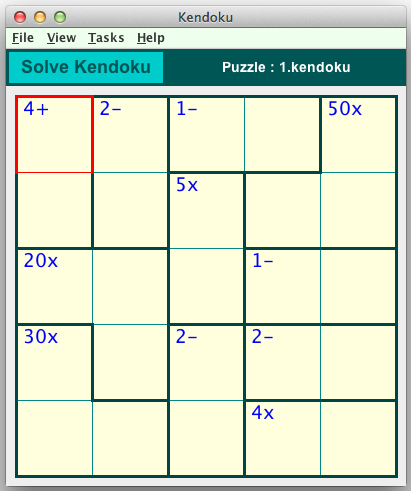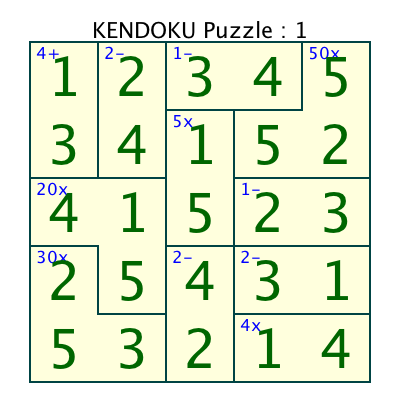KENDOKU puzzles are built on square grids of typically 5x5 cells (although puzzles having sizes in the range 4x4 up to 9x9 can
also be made). To solve them you must place numbers into the puzzle cells in such a way that each row and column contains each of the
digits from 1 up to the size of the puzzle. In this respect they are similar to Sudoku puzzles. Unlike Sudoku puzzles,
you are not given any starting digits. Instead, the puzzle is divided into Domains which are areas surrounded by a bold outline,
and containing from two up to four cells. Each domain contains a hint consisting of a number and one of the mathematical symbols
+ x — /. The number is the result of applying the mathematical operation represented by the symbol to the digits contained
within the domain. This will provide enough information to allow each of the digits to be determined. Each puzzle has a unique solution,
and no guessing is required.
The following graphics show a KENDOKU puzzle in the Crossword Express Solve screen
and a PNG graphic file produced by the program's print function, showing the complete puzzle solution.
See also a full size version of a PDF file showing the solution.
 |
 |
FEATURES
The key features of the Crossword Express Kendoku Construction function are as follows:-
-
Fully automatic construction of puzzles.
Puzzles can be built in sizes ranging from 4x4 up to 9x9.
Puzzles can be built with difficulty settings of Easy, Moderate and Hard.
A multi-build function allows the construction of many puzzles (thousands if necessary) in a single operation.
Fully manual construction is also available. This allows puzzles found in the printed media to be entered into
Crossword Express.
Puzzles can be printed in an unprecedented range of user controlled colors and formats.
Output can be sent direct to the printer or, if you install the appropriate software, it can be sent to a PDF file. The
recommended software for this purpose is Primo PDF which
you can download free from their website, although you might consider sending them a small donation if
you find their program useful. Mac users will be able to create a PDF file directly from the screen provided by
the printer driver.
Formatted output can also be exported from the Print screen to graphic files which conform to the BMP, GIF, JPG or PNG formats.
A fully interactive Solve function is available to allow you to solve the puzzles "on screen" without needing to print them.